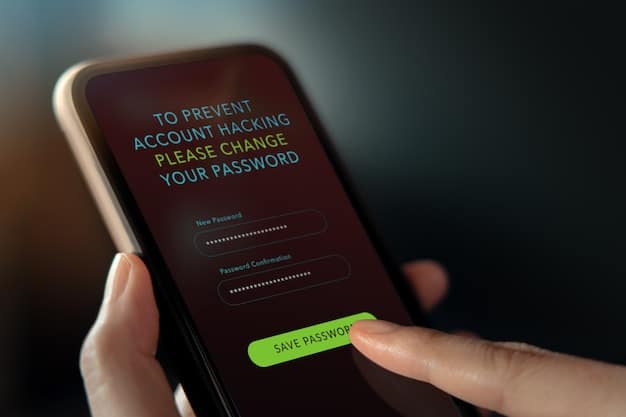Cybercrime Prevention 2025: Protecting Your Family Online

Cybercrime prevention in 2025 requires proactive measures to safeguard your family from online scams and identity theft, emphasizing education, strong passwords, updated software, and awareness of emerging threats.
The digital landscape is constantly evolving, and so are the threats lurking within it. In 2025, cybercrime prevention is no longer just a technical concern; it’s a fundamental aspect of family safety, demanding a proactive and informed approach to protect against online scams and identity theft.
Understanding the Evolving Cyber Threat Landscape
The nature of cybercrime is constantly evolving, with new threats emerging regularly. Understanding these changes is the first step in effective cybercrime prevention. Cybercriminals are becoming more sophisticated, employing tactics that target not just individuals but entire families. Let’s explore the key areas of concern.
Phishing and Social Engineering on the Rise
Phishing attacks are becoming more personalized and harder to detect. Cybercriminals are leveraging social media and data breaches to gather information and craft highly targeted scams, making it crucial to educate family members about these tactics.
The Internet of Things (IoT) as a Security Risk
Smart home devices, while convenient, often come with security vulnerabilities. From smart TVs to baby monitors, these devices can be entry points for cybercriminals, emphasizing the need for strong passwords and regular software updates.

- Regularly update passwords on all devices.
- Enable two-factor authentication whenever possible.
- Educate family members about phishing scams and social engineering tactics.
The threat landscape is constantly shifting, requiring constant vigilance and adaptation. By understanding the evolving tactics of cybercriminals, families can better protect themselves from falling victim to online scams and identity theft.
Creating a Secure Home Network
Your home network is the gateway to your digital life, making its security paramount. A secure home network acts as the first line of defense against cyber threats, protecting all connected devices and the data they contain. Here’s how to build and maintain a robust security posture.
Strengthening Your Wi-Fi Security
Your Wi-Fi network needs more than just a basic password. Implement strong encryption protocols and consider hiding your network name to deter unauthorized access.
Firewall Protection and Network Monitoring
Ensure your router’s firewall is enabled and properly configured. Consider using network monitoring tools to detect unusual activity and potential security breaches.
- Use a strong, unique password for your Wi-Fi network.
- Enable WPA3 encryption for enhanced security.
- Regularly update your router’s firmware.
Creating a secure home network is a fundamental step in cybercrime prevention. By implementing these measures, you can ensure that your family’s digital life is protected from unauthorized access and cyber threats.
Educating Your Family on Safe Online Practices
Education is a cornerstone of cybercrime prevention. Equipping your family with the knowledge and skills to navigate the online world safely can significantly reduce the risk of falling victim to scams and identity theft. Let’s look at how to cultivate a culture of online safety within your household.
Teaching Children About Online Safety
Start early in teaching children about the potential dangers online, including cyberbullying, inappropriate content, and online predators. Emphasize the importance of not sharing personal information without permission.
Guiding Teenagers on Social Media Safety
Teenagers are often heavy users of social media, making them vulnerable to scams and privacy breaches. Teach them about privacy settings, the risks of oversharing, and how to identify and report suspicious activity.

- Establish clear rules about online behavior and screen time.
- Encourage open communication about online experiences and concerns.
- Use parental control software to monitor online activity and filter inappropriate content.
Educating your family about safe online practices is an ongoing process. By fostering a culture of awareness and responsibility, you can significantly reduce the risk of cybercrime affecting your loved ones.
Securing Your Personal Devices
Personal devices, such as smartphones, tablets, and laptops, are common targets for cybercriminals. Securing these devices is crucial to protecting your personal information and preventing unauthorized access to your accounts. Learn how to fortify your devices against digital threats.
Using Strong Passwords and Biometrics
Strong passwords are the first line of defense against unauthorized access. Use a combination of uppercase and lowercase letters, numbers, and symbols, and avoid using easily guessable information. Enable biometric authentication for an extra layer of security.
Keeping Software and Apps Updated
Software and app updates often include security patches that address known vulnerabilities. Regularly updating these programs ensures that your devices are protected against the latest threats.
Beyond passwords and updates, encryption plays a vital role in securing your data. Understanding and implementing encryption methods provides an extra layer of protection. Let’s explore this critical aspect.
Securing your personal devices is a critical component of cybercrime prevention. By implementing these measures, you can significantly reduce the risk of falling victim to scams and identity theft.
Protecting Your Financial Information Online
Financial information is highly sought after by cybercriminals. Taking steps to protect your bank accounts, credit cards, and other financial data is essential to preventing fraud and identity theft. Let’s explore the best practices for safeguarding your financial information online.
Recognizing and Avoiding Financial Scams
Be wary of unsolicited emails, phone calls, or text messages asking for financial information. Verify the legitimacy of any request before providing sensitive data.
Using Secure Payment Methods
When making online purchases, use secure payment methods such as credit cards or payment platforms that offer fraud protection. Avoid using debit cards or direct bank transfers, which offer less protection in case of fraud.
- Regularly monitor your bank and credit card statements for unauthorized transactions.
- Be cautious of online shopping deals that seem too good to be true.
- Use a virtual credit card number for online purchases.
Protecting your financial information online requires constant vigilance and proactive measures. By following these guidelines, you can significantly reduce the risk of financial fraud and identity theft.
Planning for Incident Response and Recovery
Despite your best efforts, cyberattacks can still occur. Having a plan in place for incident response and recovery is essential to minimizing the damage and restoring your digital life. Learn how to prepare for the worst and respond effectively to cyber incidents.
Creating a Data Backup and Recovery Plan
Regularly back up your important data, including documents, photos, and videos. Store backups in a secure location, preferably offsite, to protect them from physical damage or cyberattacks.
Knowing How to Report Cybercrimes
If you fall victim to a cybercrime, report it to the appropriate authorities, such as the FBI or the Federal Trade Commission (FTC). Reporting cybercrimes helps law enforcement track down perpetrators and prevent future attacks.
- Document all evidence of the cybercrime, including emails, screenshots, and transaction records.
- Change passwords on all affected accounts immediately.
- Monitor your credit report for signs of identity theft.
Planning for incident response and recovery is a critical aspect of cybercrime prevention. By having a plan in place, you can minimize the damage from cyberattacks and restore your digital life as quickly as possible.
| Key Point | Brief Description |
|---|---|
| 🛡️ Secure Networks | Use strong passwords and encryption for home Wi-Fi. |
| 🧑🏫 Family Education | Teach family members about phishing and online safety. |
| 🔒 Device Security | Keep software updated and use strong passwords on devices. |
| 💰 Financial Protection | Monitor accounts and use secure payment methods online. |
Frequently Asked Questions
▼
Phishing remains prevalent, with attackers using sophisticated methods to steal personal and financial information. Awareness and caution are key defenses.
▼
Educate children about online safety, monitor their online activity, and use parental control software to filter inappropriate content and restrict communication with strangers.
▼
Immediately report the incident to the Federal Trade Commission, contact your bank and credit card companies, and monitor your credit report for unauthorized activity.
▼
Use a combination of uppercase and lowercase letters, numbers, and symbols. Avoid using personal information or common words. Consider using a password manager to generate and store strong passwords.
▼
Enable automatic updates whenever possible. Otherwise, check for updates regularly, at least once a week, to ensure your devices are protected against the latest security threats.
Conclusion
In 2025, cybercrime prevention is an ongoing effort that requires vigilance, education, and proactive measures. By understanding the evolving threats, creating a secure home network, educating your family, securing your personal devices, protecting your financial information, and planning for incident response, you can significantly reduce your risk of falling victim to online scams and identity theft.





